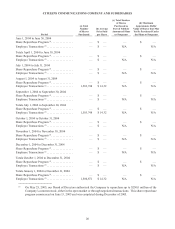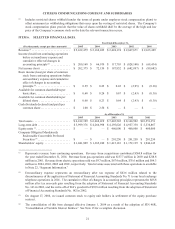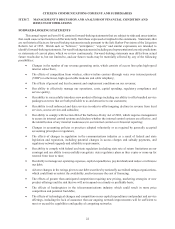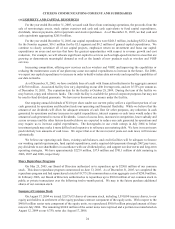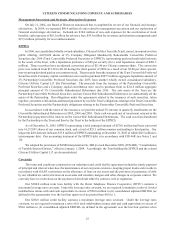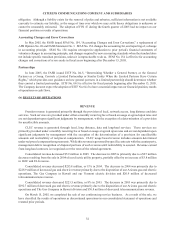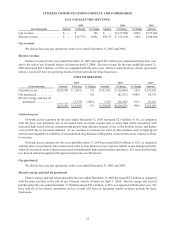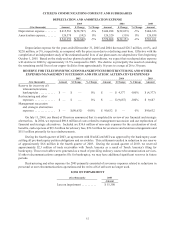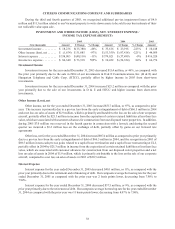Frontier Communications 2005 Annual Report Download - page 32
Download and view the complete annual report
Please find page 32 of the 2005 Frontier Communications annual report below. You can navigate through the pages in the report by either clicking on the pages listed below, or by using the keyword search tool below to find specific information within the annual report.
30
CITIZENS COMMUNICATIONS COMPANY AND SUBSIDIARIES
another decrease in the year-end discount rate, we recorded an additional minimum pension liability in the amount
of $36.4 million with a corresponding charge to shareholders’ equity of $22.5 million, net of taxes of $13.9 million.
These adjustments did not impact our net income or cash flows.
Actual results that differ from our assumptions are added or subtracted to our balance of unrecognized actuarial
gains and losses. For example, if the year-end discount rate used to value the plan’s projected benefit obligation
decreases from the prior year-end then the plan’s actuarial loss will increase. If the discount rate increases from the
prior year-end then the plan’s actuarial loss will decrease. Similarly, the difference generated from the plan’s actual
asset performance as compared to expected performance would be included in the balance of unrecognized gains and
losses.
The impact of the balance of accumulated actuarial gains and losses are recognized in the computation of
pension cost only to the extent this balance exceeds 10% of the greater of the plan’s projected benefit obligation or
market value of plan assets. If this occurs, that portion of gain or loss that is in excess of 10% is amortized over the
estimated future service period of plan participants as a component of pension cost. The level of amortization is
affected each year by the change in actuarial gains and losses and could potentially be eliminated if the gain/loss
activity reduces the net accumulated gain/loss balance to a level below the 10% threshold.
We expect that our pension and other postretirement benefit expenses for 2006 will be $15.0 million to $18.0
million (they were $19.0 million in 2005) and that no contribution will be required to be made by us to the pension
plan in 2006. No contribution was made to our pension plan during 2005.
Income Taxes
Our effective tax rate is below statutory rate levels as a result of the completion of audits with federal and state
taxing authorities and changes in the structure of certain of our subsidiaries.
Management has discussed the development and selection of these critical accounting estimates with the Audit
Committee of our Board of Directors and our Audit Committee has reviewed our disclosures relating to them.
New Accounting Pronouncements
Accounting for Asset Retirement Obligations
In June 2001, the FASB issued SFAS No. 143, “Accounting for Asset Retirement Obligations.” SFAS No. 143
applies to fiscal years beginning after June 15, 2002, and addresses financial accounting and reporting obligations
associated with the retirement of tangible long-lived assets and the associated asset retirement costs. We adopted
SFAS No. 143 effective January 1, 2003. The standard applies to legal obligations associated with the retirement of
long-lived assets that result from acquisition, construction, development or normal use of the assets and requires that
a legal liability for an asset retirement obligation be recognized when incurred, recorded at fair value and classified
as a liability in the balance sheet. When the liability is initially recorded, the entity will capitalize the cost and
increase the carrying value of the related long-lived asset. The liability is then accreted to its present value each
period and the capitalized cost is depreciated over the estimated useful life of the related asset. At the settlement
date, we will settle the obligation for our recorded amount or recognize a gain or loss upon settlement.
Depreciation expense for our wireline operations had historically included an additional provision for cost of
removal. Effective with the adoption of SFAS No. 143, on January 1, 2003, the Company ceased recognition of the
cost of removal provision in depreciation expense and eliminated the cumulative cost of removal included in
accumulated depreciation, as the Company has no legal obligation to remove certain long-lived assets. The cumulative
effect of retroactively applying these changes to periods prior to January 1, 2003, resulted in an after tax non-cash
gain of approximately $65.8 million recognized in 2003.
Stock-Based Compensation
In December 2002, the FASB issued SFAS No. 148, “Accounting for Stock-Based Compensation – Transition
and Disclosure, an amendment of FASB Statement No. 123, “Accounting for Stock-Based Compensation.” SFAS No.
148 provides alternative methods of transition for a voluntary change to the fair value based method of accounting


